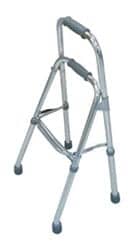If many wheelchair suppliers go out of business this year, the therapist’s role in the health care continuum could get complicated. Many PTs and OTs rely on equipment suppliers to substantiate and help document the need for a particular piece of equipment.
The competitive bidding program could upset the delicate chain of expertise. Leaving fewer suppliers and a diluted pool of knowledge threatens the relative stability of the past 4 years, since the major national coverage determination (NCD) of 2006, a coverage policy that Mark Schmeler, PhD, OTR/L, ATP, assistant professor at the University of Pittsburgh, characterizes as “relatively well accepted” in the therapy community. The NCD expanded codes from an anemic five to more than 60, while also offering better guidelines as to when a power wheelchair is covered.
The tug of war between least costly alternative and most medically appropriate is ongoing. While allowables on many devices have been significantly cut, complex rehab devices (Group 2 single power option and all Group 3) were exempted from competitive bidding.
Lauren E. Rosen, PT, MPT, ATP, steers clients to equipment that is most medically appropriate. Sometimes that is the least costly alternative, sometimes not. Rosen favors frank discussions with all involved. “I say what I think is most medically appropriate, but we also talk about the limitations of the particular funding source,” says Rosen, program coordinator at St Joseph’s Children’s Hospital of Tampa, Fla. “In some cases, if it is legal and appropriate, my financially able patients will make up the difference between what the funding source will fund, and what is most medically appropriate.”
Rosen says the competitive bidding program has not affected her or her patients, mostly because 95% of her patients need complex rehab, which is exempt from the bidding scheme.
BILLER BEWARE
Failing to provide proper documentation for mobility equipment is a problem—partly because many therapists do not always understand why a product is needed. “If therapists are recommending something for a chair, whether it be a cushion, molded back, or armrest, [the supplier] must know why,” says Rosen.
While overreliance on suppliers is problematic, Rosen believes it is worse to put too much faith in billing software that automatically generates letters of medical necessity. “That gives payor sources one more reason to kick us out of the process. I created my own wheelchair assessments and templates that I use so each patient’s records contain the correct justifications, and are personalized to the patient.”
Rosen reasons that it took years for Medicare to acknowledge that therapists should be part of the requirement for Group 3 complex rehab chairs, and therapists ultimately must live up to this trust.
Schmeler believes billing software helps clinicians if proper algorithms are included, but cautions that Medicare requires documentation that comes directly from the patient’s chart, which must be a medical record. Many who use electronic health records (EHR) systems have utilized existing medical record software and tweaked it to a wheelchair assessment. “There are a lot of people trying to come up with software, but it must be compliant with HIPAA, and reviewers must recognize it as part of the record, and not some industry-generated software forms that are out there to game the system or lead a clinician to certain products.”
Schmeler’s presentations help therapists avoid pitfalls of billing and documentation. For information on his two, free, 4-hour courses, visit www.rstce.pitt.edu.
A MOVING TARGET
Selecting a power versus a manual wheelchair is an important design consideration. If the client cannot propel a manual chair and needs to be independent to function, a power chair may be prescribed. If the issue is overall extremity weakness, the client may be independent with a standard joystick-operated power chair. For those with high-level quadriparesis, alternative drive control may be used such as sip and puff, chin, head array, or tongue controls.
With myriad choices available, many agree it is worth a therapist’s time to compare brands and configurations to recommend the best mobility solution for clients.
Some clinicians believe similar products from different manufacturers have no significant differences—but that might not be the case. Manual wheelchairs seem similar and offer the same accessories—however, they may propel differently because of weight distribution over the wheels, or because of differences in weight due to accessories. Wheelchair cushions may offer similar mapping qualities and pressure distribution, but differ in stability. The range includes air cushions, amputee cushions, bariatric cushions, foam cushions, gel cushions, lap cushions, pommel cushions, saddle cushions, support pro cushions, sacral support cushions, lumbar support cushions, and wedge cushions.
Powered seating features may offer the same degree of tilt and/or recline, but users might more quickly access powered seating on one model due to the electronics. Clinicians who are unfamiliar with these details may rely on qualified suppliers to align the user’s functional and clinical needs with available technology.
Clinicians may fail to note quality differentials of similar products, such as whether bearings hold up over time, casters are truly square, electronics are reliable, and the chair drives straight. In this era of reimbursement pressure, lower-cost products may initially be easier to obtain for the user, but may end up being more expensive due to repairs, downtime, or inflexibility to change as the user’s needs progress over time.
|
When deciding on which brand or brands to recommend, therapists need to select products that offer features and performance that will meet the needs of the user and, often, the caregiver. Therapists should not shy away from recommending a final mobility system that incorporates components from several manufacturers.
Manufacturers’ in-services on new products can provide an opportunity for PTs and OTs to learn firsthand why an item is needed, how it works, what benefits it provides, and which patients it is appropriate for. Therapists should try out products themselves, and inquire about product availability and support from manufacturers to providers who sell products to users.
DIFFERENT SPOKES
Paraplegics often choose rigid frames, which are generally more durable, more energy efficient, and lighter, though they may not easily accommodate changes in the user’s status or size, and may be more difficult to transport, depending on the type of vehicle. A high-level paraplegic may opt to get rid of armrests or anti-tippers or seatbelts, because they increase a chair’s weight. Those who want to disassemble a chair and put it in the car independently may choose the most lightweight and efficient chair available.
NEW AID FOR AMPUTEES
Patients with an amputation may require additional wheelchair accessories. The axis of the wheels may need to be changed so the individual is seated with the new center of gravity centered in the chair. If patients do not wear a prosthetic limb, they may require a special cushion to support the residual lower limb, which is generally custom made with one side longer than the other, so the residual limb can have the knee in extension and avoid the risk of knee flexion contracture.
A small Pennsylvania-based company fills the niche with an amputee swing-away stump support that is compatible with many wheelchairs on the market.
WHAT’S NEW?
Rosen touts a new custom-molded back offered by a Colorado-based company, which is smaller, lighter, and more breathable. It offers an adjustable and removable multiaxial hardware system and features a lower profile than most other systems, she says.
In line with increasing interest in getting children into power wheelchairs early, many experts say power chairs may be a good option for children as young as 12 to 15 months. Seats on manual and power wheelchairs can be lowered to the floor so kids can directly interact with peers, and to help facilitate independent transfers. While joysticks are the standard option, head arrays, sip-and-puff systems, and microswitch controls are also available. Offerings include a lightweight pediatric transportation chair that handles complex positioning and mobility needs for short distances and milder positioning needs for longer trips, and features multiple seat angles, adjustable back angles, and height- and size-adjustable headrest collars.
Amy Meyer, PT, ATP, a Tennessee-based pediatric and standing specialist, favors a particular pediatric power wheelchair with seat-to-floor function and also notes a particular ultra-lightweight standing manual wheelchair. Infrared technology is available on the displays used with alternative drive controls, which allows users to operate environmental controls such as TV, DVD players, and iPods—anything that uses an infrared remote control—through drive control, such as a joystick, head array, and switches.
Many Baby Boomers prefer a mobility scooter to a power wheelchair—for its portability, profile, and price tag. Mobility scooters comprise three broad categories: a foldable or travel type, which easily packs away for transport in the trunk of a car or aboard an airliner; three-wheeled scooters, ideal for indoor use because of their turn-on-a-dime maneuverability; and four-wheeled scooters, which are stable and most suited for outdoor use. They usually have rear-wheel drive; some models feature knobby tires with high ground clearance for use over difficult terrain. Some scooters can be adapted, and with custom seating they offer new potential for a wider pool of users.
Schmeler says that as reimbursement for other devices such as scooters decreases, and the criteria to qualify for a scooter become restricted, some new lower-cost standing devices could be the next surge for Boomers.
GERIATRIC AND BARIATRIC
When addressing the needs of geriatric clients, the weight of the wheelchair, vehicle type, size of trunk, and lift accessibility need to be evaluated when choosing between a manual versus power wheelchair. Strength, endurance, active range of motion, and fine and gross motor control/coordination, including hand dexterity and grasp, are important considerations. Key is accommodating postural changes that often accompany aging. Clients need a seating system that provides support, pressure relief, cushioning, and comfort, and legrests should swing for safety when using patient lifts and transfers.
Some clinicians urge bariatric clients to try powered mobility even if they are certain they want a manual wheelchair, to feel the differences of the two experiences. Newer power chairs that house the electronic mechanism below the seat allow a larger seat to be placed on top, creating an overall narrower profile, and also allow clients to adjust the width and depth, and remove backrests. A tilt-in-space position is available for clients with strong endurance for dynamic activity. Manufacturers have replaced air in the tires on many bariatric wheelchairs with solid urethane or other durable materials.
ACCESSORIZING
Accessories aid with activities ranging from positioning, to relieving pressure, to carrying objects. Among the vast array of items are cell phone compartments; laptop workstations; side guards; tool packs; seat pouches and under-the-chair storage nets; cup or bottle holders; pneumatic or spoke tires; rims, rim covers, and spoke covers; heel loops; varied caster and tire selections; back or seat elevators; swing-away, elevating, or elevating/articulating footrests; shock-absorbing components; brake extensions; swing-away joystick mounts; push handles, including flip-down models; adaptive cushions; oxygen tank holders; stabilizers; anti-rollback mechanisms; tilt-in-space; recliners; switches for operation of environmental control systems, computers, and augmentative communication devices; drive control packages; and positioning systems.
Greg Thompson is a contributing writer for Rehab Management. For more information, contact .





